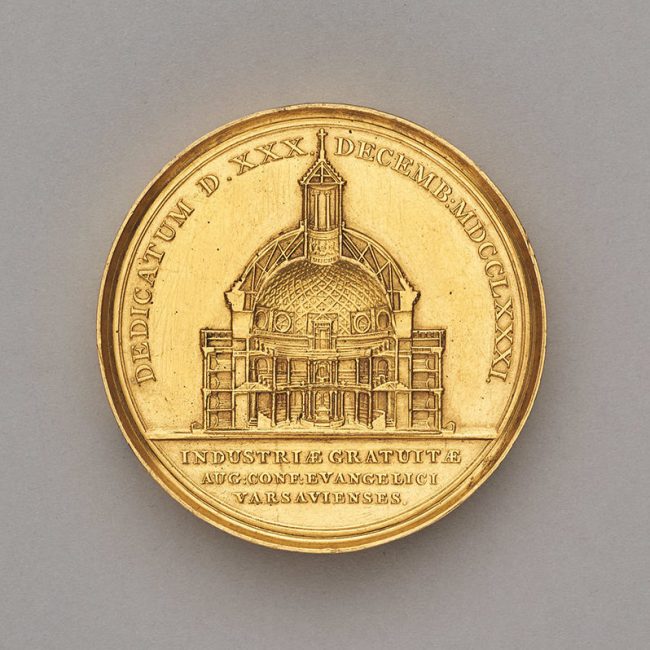
Medal dedicated to Szymon Bogumił Zug (1733–1807)
The medal was commissioned by Warsaw Evangelical Church of the Augsburg Confession as a token of gratitude to Szymon Bogumił Zug (1733–1807) for the gratuitous execution of architectural design of the temple and supervision of the construction as well as financial support that made it possible to complete the church building.
The obverse features the architect’s bust turned to the right, encircled with the inscription SIMON AMADEUS ZUG ARCHITECTUS ELECT: SAX: [Szymon Bogumił Zug architect of the Elector of Saxony], and the name of the maker of the medal: J.P. HOLZHAEUSSER located under the architect’s arm. Featured on the reverse, the cross-section of the church building – view from the entrance towards the altar – was created on the basis of one of the designs of the church.
This can be seen in the construction and decoration details that were not implemented in the final version, among them the dome which, contrary to reality, is set on a threestepped attic, and its interior is covered with coffering that appeared only in the postwar reconstruction. Additionally, the view of the organs that veil the window is different.
The rim contains the inscription: DEDICATUM D. XXX. DECEMB: MDCCLXXXI. [consecrated on 30 December 1781]. Underneath: INDUSTRIAE GRATUITAE /
AUG: CONF: EVANGELICI / VARSOVIENSES [for his gratuitous work from the Warsaw Evangelical Church of the Augsburg Confession]. The medal was stamped in bronze and silver. The only specimen in gold, whose weight equalled 64 ducats (more than 222 grams), was handed to Zug on 4 May 1784 in person by the members of the Church Council three years after consecration of the church. In 1829, the Council purchased the same medal from the architect’s heirs. It was stored in the church chancellery until the Warsaw Uprising of 1944. Its subsequent history remains unknown. It was probably still in the 18th century that several replicas were made using the technique of bronze-casting and thick fire-gilding. One of them is the unique medal presented in the Room.
Its extraordinary character also stems from the featured representation of an architectural drawing, which is rare in medallic art. What is more, the building commemorated in the medal is also unique as a testimony to the religious tolerance of the Polish king and nation, a proof of the power and significance of Warsaw’s Evangelical Borough whose ranks were additionally swelled in the 18th century by crowds of mainly German craftsmen and merchants.
Visitors and city dwellers could admire the panoramic view of Warsaw from the high roof lantern on the dome of the church. It was from here that the movements of enemy armies were observed during the Kościuszko Insurrection in 1794, which was a Polish national uprising during the period of the Partitions – initially fought against Russia, and later also against Prussia – led by Tadeusz Kościuszko (1746–1817), Polish national hero. Concerts
were held in the temple, as it boasted excellent acoustic conditions, and in 1825 Frederic Chopin (1810–1849) played here for Emperor Alexander I Romanov (1777–1825, Emperor of Russia since 1801, King of Poland since 1815). In the 1880s, the cross that crowned the dome was chosen as the central point of Warsaw’s geodesic layout for the needs of measurements pursued in relation to the construction of waterworks and sewage system designed by
William Heerlein Lindley (1853–1917).
Medal dedicated to Szymon Bogumił Zug (1733–1807)
JOHANN PHILIP HOLZHAEUSSER
WARSZAWA, AFTER 1784 (?)
GILDED BRONZE, CAST
MHW 1469
DIA. 6,7 CM
Images licensed under: ![]()

![Szymon Bogumił Zug (1733-1807) - medal zaszczytny, 1781, MHW 1469 [1]](https://muzeumwarszawy.pl/wp-content/uploads/2017/02/MHW-1469-1-150x90.jpg)
